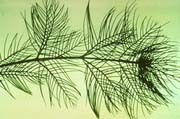
Myriophyllum spicatum
Illustration: IFAS
 |
Eurasian watermilfoil Myriophyllum spicatum Illustration: IFAS |
Eurasian watermilfoil (Myriophyllum spicatum) is a native of Europe and Asia and was once sold in this country as an aquarium plant. It is an underwater plant that has become a major problem in many of Washington's lakes, rivers, and streams.
Key Characteristics

| Click on the drawing to view it in more detail. | |
|
Eurasian watermilfoil (and other milfoil species) may be distinguished from other aquatic plants by their feather-like leaflets. However, there are also a number of native milfoil species in Washington. It's very difficult to tell the common native milfoil species from the foreign Eurasian watermilfoil, but there are some differences. |
Eurasian above
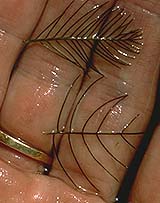
|
| Although milfoil produces seeds, it spreads mostly through fragments caused by winds, waves and boats. Milfoil fragments stuck to boats and trailers are probably the main way it spreads between water bodies. And, only a tiny fragment is needed to begin a new infestation. | |
Distribution
Eurasian watermilfoil has become widely distributed within lakes and rivers in eastern and western Washington. It is found in Lake Washington, the Columbia River, the Pend Oreille River, the Snake River, the Okanogan River, and is in many other Washington lakes.
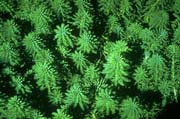 |
Parrotfeather milfoil Myriphylum aquaticum Illustration: IFAS |
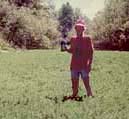 This picture shows someone walking across a dense mat of milfoil in shallow water. The brownish underwater stems (rhizomes) are very tough and the underwater leaves are often decomposed and not present. Parrotfeather milfoil forms dense mats that extend out from the shoreline into deeper water. Parrotfeather milfoil mats form ideal breeding ground for mosquitoes, and water under the mats often is very acidic.
This picture shows someone walking across a dense mat of milfoil in shallow water. The brownish underwater stems (rhizomes) are very tough and the underwater leaves are often decomposed and not present. Parrotfeather milfoil forms dense mats that extend out from the shoreline into deeper water. Parrotfeather milfoil mats form ideal breeding ground for mosquitoes, and water under the mats often is very acidic.Key Characteristics

| Click on the drawing to view it in more detail |
Parrotfeather milfoil is easy to identify. Because it is a milfoil, the leaves are feather-like in appearance, but unlike the other Washington milfoils, this species has emergent stems and leaves.
DID YOU KNOW...
Distribution
Parrotfeather is limited in distribution and has not yet been reported from eastern Washington. Although parrotfeather can spread by attaching itself to boat trailers, we believe that in Washington it has been spread through flooding and by being deliberately planted. It is found in the Chehalis River and at other locations in western Washington. Parrotfeather seems to prefer slowly-moving nutrient-rich waters. Once established, parrotfeather milfoil is extremely difficult to control.
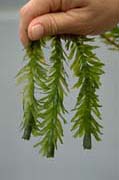 |
Brazilian elodea Egeria densa Illustration: IFAS |
Brazilian elodea (Egeria densa) is a South American native, that until 1996, was sold in pet stores as the very popular aquarium plant, Anacharis. The characteristics that make Brazilian elodea a good aquarium plant (rapid growth under low light levels, easy propagation, and tolerance of a wide range of water and sediment types) also make it a nuisance aquatic plant, when it escapes and grows in lakes and streams. Brazilian elodea is a densely-leafed, bright green, robust underwater plant. It overwinters in an evergreen state and grows rapidly in the spring, forming a canopy of intertwined stems at the surface that shades out native aquatic plants. Brazilian elodea appears to outcompete Eurasian watermilfoil when the two species occur together and can be even more difficult to control than milfoil.
Key Characteristics

| Click on the drawing to view it in more detail |
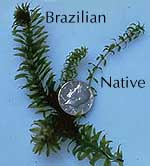
Brazilian elodea is relatively easy to identify, but it can be readily confused with its cousins, hydrilla and our commonly-occurring native American elodea.
DID YOU KNOW...
All Brazilian elodea plants in Washington are male and floating white male flowers are sometimes seen. (See also hydrilla description).
Distribution
Brazilian elodea has not been reported from eastern Washington, but occurs in a number of lakes in western Washington and is of serious concern. Local lake residents sometimes spend thousands of dollars each year for control.
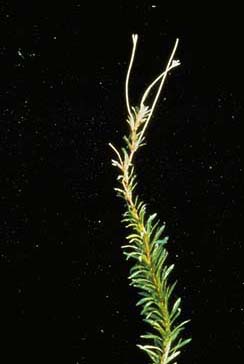 |
Hydrilla Hydrilla verticillata Illustration: IFAS |
Hydrilla (Hydrilla verticillata) is considered the most troublesome plant in North America. It is native to Australia, Africa, and some parts of Asia. Hydrilla was introduced into the United States as an aquarium plant, but is no longer sold as such. Hydrilla has been known to "hitchhike" into uninfested waterbodies on the rhizomes of waterlilies offered for sale to water gardeners. Hydrilla forms dense, tangled mats of vegetation that inhibit the growth of native aquatic plants and interfere with recreation. It grows rapidly under very low light levels, in a variety of aquatic habitats, from still to flowing waters, and in depths of an inch to 50 feet.
Key Characteristics

| Click on the drawing to view it in more detail |
Distribution
Hydrilla distribution in Washington is very limited and we want to keep it that way! If you think you have found hydrilla, contact Kathy Hamel or Jenifer Parsons immediately. It's currently limited to the Pipe and Lucerne Lake System in King County where an eradication project is underway.
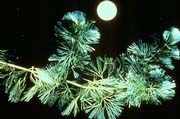 |
Fanwart Caboma caroliniana Illustration: IFAS |
Fanwort (Caboma caroliniana) is a native of our North American east coast. This beautiful underwater plant has been cultivated and hybridized as an aquarium plant. It is still legally sold in Washington for aquarium use, but has "escaped" by people dumping aquariums into western Washington and Oregon waters where it is thriving. Fanwort grows very densely and excludes native aquatic plant species. Even on the east coast, where it is native, fanwort is considered a serious aquatic nuisance.
Key Characteristics

| Click on the drawing to view it in more detail |
Fanwort has distinctive, fan-shaped underwater leaves arranged in pairs along the stem. Fanwort can be bright green to reddish in color. In the water, fanwort has a "tubular" look because the leaves are quite dense on the stem and there is little branching. Small, floating leaves may also be present. Fanwort produces small white flowers with a yellow spot near the base.
There are two other fan-shaped leafed underwater plants in Washington that can be mistaken for fanwort. The aquatic buttercup has alternate rather than opposite leaves. The water marigold has opposite leaves on very short stalks and yellow, daisy-like flowers.
Distribution
Fanwort is known to be growing in only one location in western Washington in a slough off the Columbia River in the Longview/Kelso area.
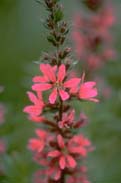 |
Purple loosestrife Lythrum salicaria Photo: COOP |
Purple loosetrife is an invasive wetland perennial that became established in North America in the early 1800's. Once established, the plant forms dense stands, driving out the native plant species and the wildlife that depends on the native plants.
Purple loosetrife appears to have little or no wildlife habitat use, but preliminary bird nest survey data in Eastern Washington showed marsh wrens nesting equally in purple loosestrife and cattails. But, the nest material was mainly cattail material. It would seem that birds may use purple loosestrife as long as cattails and other native plants exist.
Key Characteristics
Purple loosestrife's agressive growth will fill in a wetland and spread out to cover any moist soil, creating a large meadow.
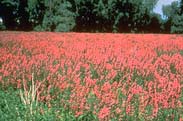
Approximately $160,000 is spent annually in Washington State to control purple loosestrife from spreading.
Distribution
It has taken 20 years for purple loosestrife to spread from the east coast and is found throughout Washington State and spreads by releasing hundreds of thousands of seeds into the wind. The seeds will grow in areas where the water is drawn down, leaving muddy areas. When the water level increases, the plants will continue to grow, as long as they stalks are above the water line.